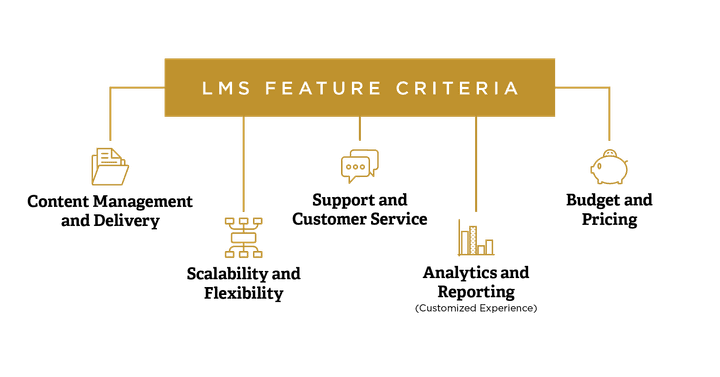You’ve extensively evaluated your learning requirements, learning culture, technical infrastructure, budget, and implementation support and have decided your organization is ready to implement a learning management system (LMS) to improve your team’s learning culture and skillsets. But, with a highly saturated market of LMS providers, discerning which tool is best for your company can be overwhelming. In this blog, we will walk through the aspects of an LMS that are key to achieving your organization’s learning and development goals.
Wondering if you’re ready for an LMS? Read this blog first!
# Understanding Learning Management Systems Objectives
Before you begin the selection process, you must first identify the objectives you want to achieve using the tool. For example, these objectives could be onboarding new hires, improving the skillsets of your team members, driving new capabilities, or creating an information-sharing platform.
When defining objectives, align them with your overall company priorities and goals. Once your objectives are defined, they will act as a guide when evaluating the factors that are key to selecting the right LMS, including:
- Content Management and Delivery
- Scalability and Flexibility
- Support and Customer Service
- Analytics and Reporting (Customized Experience)
- Budget & Pricing

Let’s take a closer look at how each of these relates to a selecting the right LMS for your organization.
# 5 Factor Key to Selecting the Right Learning Management System
# 1. Content Management and Delivery
After going through the extensive process of selecting and integrating a new LMS into your organization, ensuring the effectiveness of the delivered learning content is imperative. The content housed within your LMS plays a pivotal role in driving the success of your organization's learning and development initiatives. The success of your LMS implementation hinges not only on the platform's capabilities but also on the quality and relevance of the content it delivers.
By prioritizing relevance, quality, variety, accessibility, and analytics in your content management strategy, you can create a dynamic and impactful learning environment that empowers your team to achieve their full potential.
Consider these options when selecting content for the system:

Option 1: Existing Library
A carefully curated training developed by an experienced outside vendor
PROS: Quickly implemented
CONS: May not be exactly applicable to your needs.

Option 2: Hybrid
Both an existing library to select from and the ability to create and upload your own content
PROS: Balanced approach with some tailored content where it's most impactful
CONS: May require additional vendor/subscription costs

Option 3: Personalized Content
Ability to create and upload your own branded learning content
PROS: More tailored approach to training applicable to your organization's needs
CONS: Requires more investment in time and resources
Another option is a newer type of tool: SaaS platforms called Learning Experience Platforms, or LXPs. These platforms help tailor individual learning experiences using AI to create and curate content. They help generate content for individuals looking for a personalized development path by recommending content based on the user’s search. LXPs also provide an opportunity to integrate and track many external content types, such as courses from LinkedIn Learning, Coursera, and Pluralsight.
# Training Your Team on Content Management and Delivery
Regardless of content selection methods, thorough vetting is essential to ensure its relevance and effectiveness across the entire team. Learning material should be easily digestible, align seamlessly with intended objectives, and facilitate practical application in employees’ daily responsibilities.
Training delivery methods should be diverse and adaptable. While some organizations exclusively rely on online, self-guided modules, leveraging the capabilities of your LMS or LXP opens up a myriad of possibilities, including:
- Quizzes
- Virtual instructor-led sessions
- In-person workshops
- Pre-recorded webinars
- Interactive discussion forums.
There is no “right” delivery approach or blend of learning activity types. Incorporating diverse delivery modalities not only enhances learner engagement but also ensures a tailored approach that meets your organization's specific objectives, logistical constraints, and participant preferences.
# 2. Scalability and Flexibility
Scalability and flexibility are critical factors in identifying a tool capable of accommodating your team’s current scale, future expansion, and accessibility needs.
Scalability not only evaluates the size of your organization today but also entails forecasting its prospective growth trajectory. While small businesses might find solace in a cost-effective solution that meets their immediate needs, enterprises envisioning exponential growth must prioritize a tool that seamlessly scales alongside them.
Flexibility delves into accessibility and feature availability, helping you consider how easily your team can access the tool and its breadth of features. For instance, certain learning management systems may integrate complementary products spanning HRIS, performance management, recruitment, onboarding, mentorship, and beyond. Such adaptability ensures your organization remains agile and well-equipped to navigate evolving demands.
Below are the different types of accessibility that may be deployed and features to consider:
Advantages | Disadvantages | |
Cloud-based (SaaS) Cloud-hosted: subscription-based access to software hosted on vendor servers |
|
|
Cloud-based (SaaS) Self-hosted: subscription-based access to software hosted on private cloud |
|
|
Desktop Application: software installed on company-issued servers |
|
|
Features to Consider:
- Remote or Mobile Access
- Integration with HRIS and Other Systems
- Branding Customization
- Single Sign-On (SSO)
- User & Permission Configuration
A scalable, flexible learning management system requires an intuitive interface that will heighten user engagement and empower participants to take ownership of their learning journey. The interface should include:
- A clean and organized layout coupled with seamless navigation ensures easy access to courses, assignments, and resources.
- Intuitive search and filter functionalities to facilitate ease of content discovery.
- Responsive design that offers accessibility across a spectrum of devices.
- Customizable dashboards to help users tailor their learning experience and effortlessly monitor their progress.
Such user-centric design principles not only bolster employee satisfaction but also yield enhanced learning outcomes, pushing your organization closer to its learning and development aspirations.
# 3. Reporting and Analytics
When considering your learning management system, it's important to examine two distinct types of reporting: user-facing and back-end.
User-facing reporting encompasses tracking and reporting mechanisms accessible to individual users, enabling them to monitor their learning journey. This includes insights into completed courses, attained certifications, and progress along predefined learning paths.
Conversely, administrators leverage back-end reporting to assess the LMS's efficacy and gather comprehensive data on various metrics such as usage patterns, course completion rates, and overall performance outcomes.
Both user-facing and back-end reporting functionalities should seamlessly align with your organizational objectives, offering ease of management and customization. Minimal support should be required from the provider to tailor these reporting features to your specific needs, ensuring a seamless integration with your learning and development initiatives.
According to the LinkedIn Learning Workplace Learning Report 2023, some of the top ways to measure the success of your LMS include:
- Employee satisfaction via survey
- Employee satisfaction, informal or qualitative feedback
- Number of employees taking courses or training
- Employee performance on post-learning quizzes or assessments
- Number of courses or training each employee has completed


# 4. Support and Customer Service
Even the most easily managed tools will require regular maintenance and support from the vendor to ensure reliability and effectiveness. Ensuring vendor accessibility during standard working hours or common training schedules can mitigate numerous potential frustrations and should be considered. Moreover, beyond general support, a vendor committed to consistently addressing bugs and implementing updates to the tool is invaluable. This proactive approach enhances your company's capacity to consistently leverage new tools and features without needing to procure a new solution every few years.
# 5. Budget & Pricing
Finally, the most common deciding factor in selecting an LMS may be budget and pricing. What tool will meet all your needs while remaining cost-effective for your organization?
However, the process isn't as straightforward as merely setting a total budget for a one-time purchase. There are four common pricing structures to consider:
- Licensing: entailing either an annual or upfront fee that grants unlimited access, this model may necessitate future purchases for upgrades.
- Subscription: users pay on a regular cadence, typically on a per-user basis.
- Freemium: offering basic free features with the option to upgrade or purchase add-ons as needed.
- Perpetual License: involving a one-time purchase fee for ongoing access to the LMS.
Carefully evaluating these pricing structures in alignment with your organization's financial objectives and usage requirements is essential to ensure optimal cost-effectiveness in your LMS investment.
# Navigating the Implementation Phase: Ensuring Success Beyond LMS Selection
Selecting the right learning management system (LMS) marks only the initial phase of your organization's learning journey. The next step, implementing the chosen system, can pose significant challenges, particularly for those lacking experience in technology implementation or change management.
Fortunately, several options exist to facilitate this transition. Options include hiring specialized IT personnel dedicated to overseeing the implementation process, leveraging implementation teams provided by the LMS vendor, or seeking assistance from firms specializing in technology implementation and change management.
If you are interested in implementing an LMS in your organization but need assistance defining your objectives, selecting the right tool, implementing it, or ensuring your team's successful adoption, consider partnering with the experts at Propeller.




